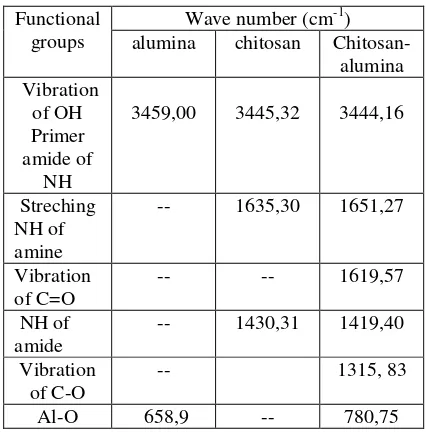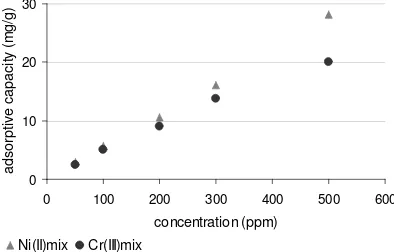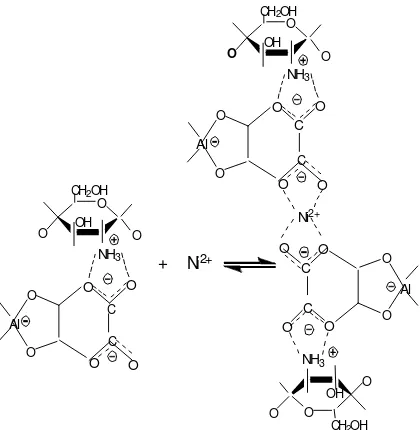THE ADSORPTION CAPACITY OF CHITOSAN -ALUMINA TO Cr(III)
AND Ni(II) IONS
Endang W. Laksono
Department of Chemistry Education, Faculty of Mathematics and Natural Sciences Universitas Negeri Yogyakarta, Karangmalang Yogyakarta, 55281, Indonesia
e-mail : ewxlaksono@yahoo.com
Abstract
The research is aimed to synthesize of chitosan impregnated on alumina and to characterize its adsorptive capacity towards Cr (III) and Ni(II) ions individual and Cr(III)-Ni(II) mixture. Chitosan was isolated from green crab’s shell (Scylla Serrata) which then wet impregnated to alumina producing chitosan-alumina. The adsorption experiment was carried out at room temperature for 24 hours at pH system 4,5. A half gram of chitosan-alumina was added into 50 mL solution of Cr(III), Ni(II) and Cr(III)-Ni(II) (1:1) mixture to measure the adsorption capacity. The result shows that metal ions were individually and simultaneously adsorbed by chitosan-alumina. Chitosan-alumina was characterized by FTIR and the adsorption capacity determined by Atomic Absorption Spectrophotometer, and giving the adsorption capacity of Ni(II) ion (47 mg/g) was greater than Cr(III) ion (24 mg/g). Whereas adsorption capacity of each ion in the mixture solution were 28 mg/g for Ni(II) and 21 mg/g for Cr(III) in agree with the result of the adsorption capacity of the individual ions. The greater adsorption capacity of Ni(II) than Cr(III) is due to Cr(III) the clustered faster than adsorbed.
Introduction
The existence of heavy metal in waterways can be endangered to human and its environtmental by which it is required a method to reduces the amount of heavy metal in the waterways [1]. One of important method applied is metal adsorption using adsorbent such as bentonite, zeolite and chitosan.
Industrial liquid waste may contain poisonous chemicals i.e Pb(II), Cu(II), Ni(II) and Cr(III) [2], and so need to be processed with a cheap and simple technology. Liquid waste treatment may envolve presipated ion, or adsorption.
Endang W Laksono, Jaslin Ikhsan et al [3] confirms the chitosan can adsorb metal ions such as Cr(III), Fe(II), Pb(II), Zn(II), Ni(II),Cu(II), Cd(II), Co(II), Mn(II) Fe(III) and Al(III) in solution without any complicated initial treatments. Chitosan and metal ions bond in complex mechanism using two functional groups of chitosan i.e -OH and NH2 and
form a multilayer [4].
The highly adsorptive capacity of chitosan to metals can be obtained by studying the adsorption models of metal ions in chitosan. Impregnated can be successfully synthesized by understanding the types
of chitosan-metal interactions. To increase the adsorptive capacity, chitosan are combined with another particular component such as succinate acid [5]or chelated with chelating agent [6] or supported with 3,4 dihydroxylbenzoic acid [7].
Chitosan is a deacetylated product of chitin a natural biopolymer found in arthropoda shells such as crab’s shell. Darjito [8] arranged the active sites of chitosan by impregnated the chitosan on alumina. Impregnation of Chitosan on the alumina result in distribution active sites randomly over the alumina surfaces. The impregnation of chitosan on the alumina is expected to be able to increase of adsorption ability of chitosan to Cr(III) and Ni(II) ions.
Experimental methods
Chitosan were isolated from green crab’s shell. This preparation method is adopted from Hong [9] involving : (i) deproteination (ii) demineralization and (iii) deasetylation. The 40 mesh green crab’s shell is refined, pounded and strained and also added with 3,5% NaOH and refluxed at 65OC for 2 hours. After that the mixture was filtered and the residue was rinsed until neutral. Demineralization is undertaken by mixing residue with dilute chloride acid (1M) and refluxing at the 60O C. The result of the process is chitn. Deasetylation is undertaken by mixing residue with concentrated sodium hydroxide and refluxing on the 100OC . At room temperature the strain and reside are washed with water until neutral. The residue is analyzed using Infra Red Spectrophotometer (FTIR).
material is dried in the oven at 55°C for 5 hours. The sample is characterized by Infrared spectroscopy.
The adsorption capacity of chitosan- alumina is determined based on the selected cationic concentration that is between 100-500 ppm. The adsorption capacity chitosan- alumina toward Ni(II) and Cr(III) are studied by comparing the concentration each ions before and after adsorption process. The ions concentrations are measured by Atomic Adsorption Spectrophotometer (AAS). The adsorption is carried out at room temperature for 24 hours in optimal pH system using a adsorbat: adsorbent proportion of 100:1.
The pH of the adsorption system is arranged using nitric acid 0,01 M or sodium hydroxide 0,01 M. A half gram of chitosan-alumina was added into 50 mL Cr(III) and Ni(II) solution, and the concentration is 300 ppm. The optimizing of pH experiment was carried out at room temperature for 24 hours. The adsorption capacity of the sorbent is determined by comparing the concentration of the each ions before and after adsorption process.
Result and Discussion
The chitosan is impregnated in the alumina-oxalic gel, and the reaction is described in Figure 1.
Alumina-oxalic chitosan chitosan-alumina
Figure 1. The formation of chitosan- alumina bonds
The carboxyl groups of alumina-oxalic are coordinated with –NH2groups of chitosan. The active
sites of chitosan-alumina are NH3+ groups and
carboxyl groups, the carboxyl groups has a negative (-) charge. All of the active sites are possible to bond with cations in adsorption process.
The Infra Red spectra of chitosan-alumina and the interpretation of the spectra are presented in Figure 2c, and Table. 1. The functional groups of chitosan spectra can be seen on the Figure. 2b, and the functional groups of alumina shown in Figure. 2a. Vibration of NH-amine groups of chitosan are indicated by band 1635 cm-1. The amide (NH2) of
chitosan is appeared at 1430,31 cm-1(Fig. 2b)
The absorption band of active sites (NH2groups)
of chitosan-alumina moved from 1430,31 cm-1 to 1419 cm-1, and the other active sites (carboxyl groups) is appeared at 1315,83 cm-1. The–NH2group of
chitosan-alumina is more intens than chitosan (1654
cm-1). The vibration of Al-O groups shifted from 658,9 cm-1(Fig. 2.a) to 780,75 cm-1(Fig.2.c)
Figure 2. The IR Spectra of Alumina(a), chitosan (b)and chitosan-alumina (c).
Table 1. The interpretation of the IR Spectra
Wave number (cm-1) Functional
groups alumina chitosan Chitosan-alumina
3459,00 3445,32 3444,16
Streching NH of amine
-- 1635,30 1651,27
Vibration of C=O
-- -- 1619,57
NH of amide
-- 1430,31 1419,40
Vibration of C-O
-- 1315, 83
Al-O 658,9 -- 780,75
Optimation of pH System
The pH system is optimized for individual of Ni (II) and Cr (II) adsorption. The relation between the adsorption capacity and pH system are presented in the Figure 3 and 4. The pH of the system for optimum individual adsorption Ni(II) and Cr(III) are 4,9 and 4,3 respectively.
Kitosan - alumino
Figure. 3. Curve between pH system and adsorptive capacity chitosan- alumina to Ni(II)
The comparisons of the adsorption capacity of chitosan- alumina to ion Ni(II) and Cr(III) were carried out at the pH at 4,5, i.e the mid value of 4,3 and 4,9.
Figure. 4. Curve between pH of system and adsorptive capacity of chitosan- alumina to Cr(III)
Adsorption Capacity of Chitosan- Alumina
Figure 5a shows the adsorption capacity of chitosan- alumina to Ni (II), Cr (III) and Figure 5.b shows the adsorption capacity chitosan-alumina to Ni (II)-Cr (III). The adsorption capacity of chitosan-alumina to Ni (II) is higher than of the Cr (III) for both individual and the mix. The higest adsorption capacity of chitosan- alumina to Cr(III),and Ni(II) is 24 mg/g and 47 mg/g, respectively. And the highest adsorption capacity of chitosan alumina to Ni(II) and to Cr(III) is 21 mg/g and 28 mg/g in Ni(II)-Cr(III) mixture (Figure 5.b). The Figure 5.b also show that at low concentration the chitosan-alumina adsorb, Ni(II) ion similar to the Cr(III) ion. It is possible that the adsorption of chitosan-alumina-Cr(III) ions interaction reached equilibrium first compare to chitosan-alumina -Ni(II)
Figure.5a. The adsorption capacity of chitosan-alumina to Ni(II) and Cr(III) individually
If we compare the adsorption capacity of chitosan-alumina to Ni(II) and Cr(III), the adsorption capacity of chitosan-alumina to Ni(II) is higher than Cr(III) individually and their mixture. Although Cr(III) is a hard base, and the carboxyl is a hard acid, and those they are easly combine to form a
cluster on alumina. In fact, the chitosan-alumina adsorbe the Ni(II) more than the Cr(III) individually and the mixture Ni(II)-Cr(III).
0
Figure.5b. The adsorption capacity of chitosan-alumina to Ni(II) and Cr(III) in Ni(II)-Cr(III) mixture
Assuming that the condition of their adsorption process is same and the surfaces are homogene, it is means that the adsorption capacity of chitosan-alumina is really depended on the nature of the cations. The Cr(III) form a cluster in water [10]. It is possible that the Cr(III) cluster formation is faster than that of Cr(III) binding to active sites of the chitosan-alumina. The other reason is that the cluster formed between Cr(III) and water causing slow movement of the Cr(III) cluster binding the active sites of chitosan-alumina sorbent.
There are four forms active site that might be involved in the adsorption process, form of chitosan, chitosan-oxalic, alumina-oxalic and chitosan-alumina. In the experiment of the optimum pH is 4.5, so that cluster amine can changes in ion R-NH3+which metal
ions still bound up on the surface of chitosan, and there is less possibility of the use NH2bonded to the
metal ion. The possibility reaction is [11]:
R-NH2+ M2 +R -NH2M2+………….. i)
R-NH3 ++ M2 + R-NH2M2 ++ H+... ii)
R is a other groups of chitosan , except –NH2
The NH2groups as the active sites of chitosan bind
with cation M2+directly (reaction i). In reaction (ii), the M 2+ is exchange with H+, so the end of the reaction the pH of the system is decreased. Because in this experiment the pH of the system didn’t changed so the reaction (ii) is impossible.
interaction formed a cluster via the carboxyl groups. Thus the interaction depends on the number of carboxyl groups of chitosan- alumina.
Figure 6. The formation of chitosan-oxalic
Figure 7. The active sites of alumina-oxalic
Figure 8. The reaction of cation with chitosan-alumina
5
Figure.9. The IR spectra of chitosan-alumina after adsorption
The IR spectra of chitosan-alumina after adsorption is presented in Figure 9. The bands of the functional groups are shifted i.e the carboxyl group from 1619,57 cm-1 to 1622,49 cm-1; the NH amine group from 1419,40 cm-1 to 1427,53 cm-1. The movement of the band is indicated that the surface environtment is changed. The changement is caused the interaction between surfaces and cations.
In the end of the adsorption process, the pH of system did not changed. It is means that the cation is bonded the clucter carboxyl as active sites directly. There is no ion exchange between hydrogen ions (H+) and cations.
Conclusion
The result show that adsorption capacity of chitosan-alumina sorbent towards Cr(III) and Ni(II) is 24 mg/g and 47 mg/g, respestively. The adsorption capacity of the sorbent towards the cations in the competitive sorption system shows significant different amount, which is 21 mg/g and 28 mg/g towards Cr(III) and Ni(II) cations repectively. The Cr(III) cation less adsorbed than that of Ni(II) because Cr(III) cation forms cluster in water, causing low movement of the Cr(III) cluster binding the active sites of chitosan alumina sorbent.
Reference
[1].C. Gerente; V. K. C. Lee; P. Le Cloirec; G. McKay,
Critical Reviews in Environmental Science and
Technology, 37, 1 (2007) , pp 41 – 127
[2]. Siti Marwati, Regina Tutik P dan Marfuatun,
Proseding Seminar Nasional MIPA,FMIPA UNY,
(2008) pp 23-30
[3]. Endang W Laksono, Jaslin Ikhsan, and AK.
Prodjosantoso, Proceeding International Conference
of Mathematics and Natural Scinces, Bandung :
November, (2006) pp. 912-916
[4]. Endang W Laksono, Jaslin Ikhsan dan A.K. Prodjo santoso, Proseding Seminar Nasional Kimia, FMIPA UNY, (2008), pp 51-60
[5 ]. Katutoshi I, Kazuharu Y, Keisuke O,Analytica
Chemica Acta, 388, 1-2, (1999), pp 209-218
[6]. Ebru B, Arzu E, Adil D, Ridvan S,Analyca Chemica Acta, 565, 2, (2006), pp 145-151
[7]. Ketrin KR, Takayanagi T, Oshima M, et al,Analytica
Chemica Acta, 558, 1-2, (2006), 246-253
[8]. Darjito, Danar Purwonugroho and Siti Nasirotun,
Indonesia Journal of Chemistry, 6, 3, (2006),
pp.238-244
[9]. Warlan Sugiyono.Jurnal MIPA, UNNES, 4, (2002) , pp 26-39.
[10]. Jean -Pierre Jolivet. De la Solution a l’oxyde. Paris : Savoirs Actuel, (1994), pp. 235-240
[11].Jin, L and Bai, R. (2002). Machanisms of Lead
Adsorption on Chitosan/PVA Hydrogel Beads.
Langmuir. 18(25) : 9765-9770.


